Phase 4 — Mastering the Gentleman Spy Skill Set
Lesson 3 — Medical Training
LESSON 3: Medical Training

Gunshots, knife wounds, falls, poisoning. All in a day’s work for our man of action. Any man who spends enough time living the life of adventure will be exposed to multiple medical problems, either something that has happened to you, or somebody close to you. The hero is always there to save the day. You should be too. But where to start?
There’s no need to go to medical school, or even become an Emergency Medical Technician (EMT) in order to have the skills and tools to come through in a pinch. How many times have you been around when somebody has cut themselves, fallen and broken a bone, or had some other medical emergency? If you have, did you have the training and tools necessary to fix the problem? You will now.
Training
Medical training comes in various forms, from many different sources. We’ll focus on just a few:
First Aid/CPR/AED
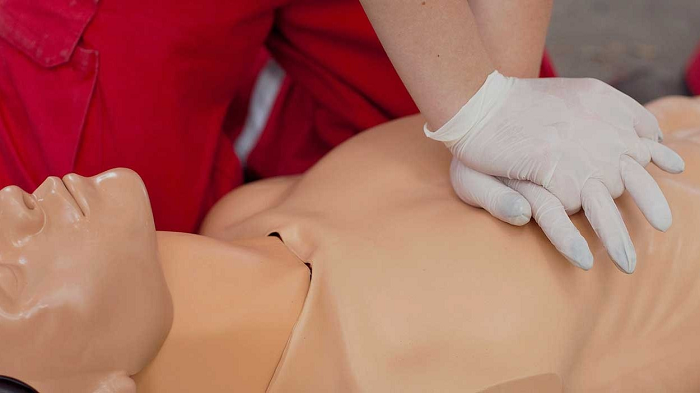
Basic First Aid/CPR/AED training is available from many venues, but the Red Cross is the standard. Almost every city has a Red Cross or Red Crescent chapter that provides basic first aid training. A basic course will teach you the necessary skills to deal with minor first aid emergencies, perform CPR, and often operate the automated external defibrillators (AEDs) that are becoming more common in public areas and workplaces.
With a training commitment of only two to five hours and a cost under $100, this training is affordable and accessible on almost everybody’s budget. There are even online training sessions available for those who don’t live near a Red Cross location.
If you do not have current lifesaving training, there is no excuse for not taking the basic course at your local Red Cross chapter.
Responding to Emergencies/EMR
Stepping up from the basic course, but still available through the Red Cross, you have Responding to Emergencies, a 30-hour course designed for high school and college students (but likely available to the general public), and Emergency Medical Response, a 51-hour course that is the first step in professional training towards becoming an EMT.
Either course should still be fairly accessible for most people — a limited time commitment and comparatively minor financial commitment will give you a more refined skill set that could very likely save the life of somebody around you. At this level, you’re still dealing with relatively minor first aid, CPR, and AED operation, but the education is more in depth and will include far more hands-on training to further solidify your new skills.
Emergency Medical Technician (EMT)
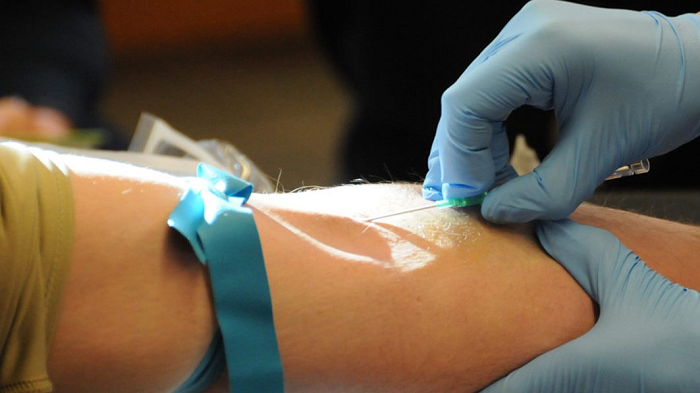
Advanced medical training is not necessary for most people, but for those who take their outdoor adventures seriously or who are regularly exposed to injuries, going through a full Emergency Medical Technician (EMT) program is likely worth the effort. Community colleges usually offer one-semester EMT courses, but the option that best fits the adventurous lifestyle is a Wilderness EMT course.
While a regular EMT course will provide an immense amount of lifesaving information, it is geared towards an urban environment with functioning EMS services. In contrast, the Wilderness EMT course is designed for remote locations where care is hours or days away. This course also covers the requirements for the US Coast Guard’s Medical Person In Charge program so it may be even more helpful for those who spend a significant amount of time on the water.
Wilderness EMT programs are available at a variety of locations, but the standout is Remote Medical’s Remote EMT course, hosted at their facility in Leavenworth, Washington. The best of its breed, Remote EMT training is a significant investment — 26 days and a cost of almost $3,700 — but for those who plan to live at extremes, this is a worthwhile investment.
Tactical Medical Training
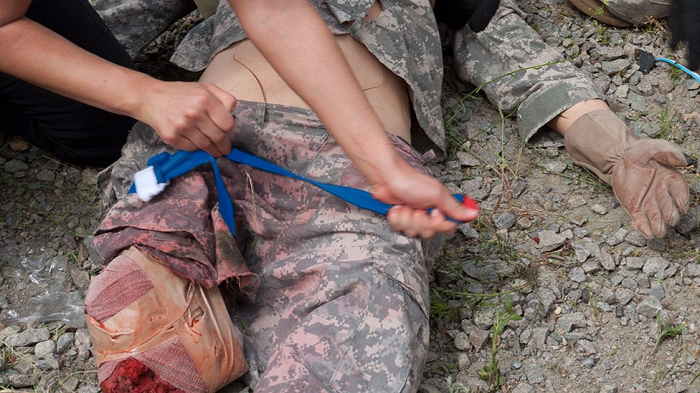
Changing gears from the more traditional medical training options is a new development:
A byproduct of the extensive military operations that have taken place around the world after the events of September 11, 2001, there are now thousands of highly trained medical professionals with tremendous experience in tactical medicine. Instead of treating the bumps, bruises, and chronic illnesses common to the civilian medical field, these military medics are expert at dealing with amputations, gunshot wounds, and other massive traumas. Their experience in the worst environments in the world, and subsequent experiences coming back home, have led to the creation of a new type of course: Tactical Medical Training.
Based largely on TCCC (Tactical Combat Casualty Care), this training could prove invaluable for anybody who trains often with firearms or who spends significant amounts of time in areas where the human predator is the greatest threat (war zones, many inner cities, third world countries, failed economies, etc.).
This new breed of course is usually not accredited and may or may not meet any state or federal requirements as most Red Cross or EMT programs do. Programs are offered with names like Tactical Medicine for the CCW Operator, Tactical Aid Course, or Dynamic First Aid.
Rather than simple first aid, these courses are often held over a weekend and focus on massive hemorrhage control with tourniquets and hemostatic bandages; airway management including dealing with tension pneumothorax, sucking chest wounds, and nasopharyngeal airway use; treating for shock; and triage procedures for mass casualty events or active shooter scenarios.
If you decide that a course of this type is right for you, do your research and pick a vetted outfit like Dark Angel Medical, Lone Star Medics, Tactical Medics Group, or others that offer this type of training to civilians.
Equipment
With training, you need the equipment necessary to save a life. When most people think of a first aid kit, they think of the small kits in red pouches that contain band-aids, maybe some painkillers, antibiotic ointment, and little else. These might be fine for some of life’s inconveniences, but they don’t hold up when confronted with a major emergency. Thankfully, there are better options.
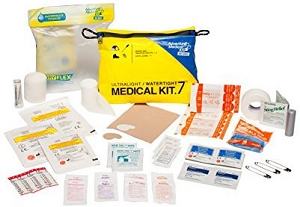
Personal First Aid Kit
First, we have the “standard” first aid kits put together for people who are regularly exposed to more in depth problems than most — outdoor enthusiasts, adventure racers, mountaineers, etc. Available through companies like Adventure Medical Kits and Remote Medical, these are far better than what you’ll find in the local drug store. These contain the usual supplies — band-aids, antiseptic, and painkillers, but generally go a step further with butterfly closures, gauze, and wraps to immobilize injured limbs. These are a good off the shelf option for general use, and an excellent starting point for putting together a more advanced kit.
GS Recommendation: Adventure Medical Kits Ultralight & Watertight (.5, .7, or .9, depending on size and weight considerations), or build your own.
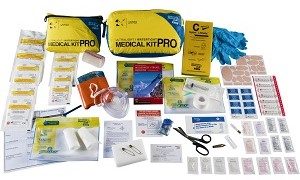
Advanced First Aid Kit
Like the personal first aid kits, these are commercially available from various manufacturers. Generally designed for expedition use, these add more of the basics, as well as some more specialized tools. At this point, things like CPR masks, flexible SAM splints, EMT shears, and trauma pads. For dealing with anything other than the smallest injuries, these are a far better choice. These larger kits aren’t generally the kind of thing that most people will carry on them all the time but make excellent choices (or starting places) for a kit to keep in your vehicle, home, and office.
GS Recommendation: Adventure Medical Kits Ultralight/Watertight Pro or build your own.

Trauma Kit
Originating in the military and “tactical” communities are the new breed of personal trauma kits — often referred to as blowout kits. These are designed to deal with the most life-threatening injuries likely to be sustained in the field: extremity hemorrhage, tension pneumothorax, and airway obstruction.
Gone are the band-aids and Tylenol in a zippered case, replaced by chest seals, combat gauze with integrated coagulating agent, Israeli bandages, nasopharyngeal airways, and chest decompression needles. Some kits contain tourniquets and some require you to add your own (which you must). These kits are small enough to be carried in a briefcase, backpack, or vehicle, and even pocket-sized versions for everyday carry.
GS Recommendation: Phokus Research Group. The Advanced Vehicle trauma kits are perfect to stow in a vehicle, at the office, in a briefcase, backpack, range bag, etc. — anywhere you need a fully self-contained kit — and the Shield kit as an everyday carry option. The Deployment and Low Vis kits are good for duty or armed citizen use when you'll carry a tourniquet elsewhere.
For the business owners: investing in a Bleeding Control Pack (4-person; 8-person) should be a business expense and could save the lives of your customers, patrons, or employees in the event of an active shooter, industrial accident, etc.
*Use code GENTLEMANSPY to save 10% when you order from Phokus.*
It is highly advised that whenever possible, you would have both types of kit available: a general purpose first aid kit for daily use, and a trauma kit for major disasters. Whether you’re at home, in your vehicle, or at your office, these kits can be kept out of the way in a desk drawer or glove box and used as necessary.
Additional Tools
For those with special requirements, or simply those that take the health and safety of those around them more seriously, there are four more additions that are worth considering: glucose, epinephrine auto-injectors, automated external defibrillators, and oxygen kits.

Glucose
If you or your loved ones are diabetic, you already know you should have this. But even if not, diabetic hypoglycemia is one of the most common medical emergencies in the US that is easily treatable with a few dollars worth of glucose, an inexpensive addition to any medical kit.
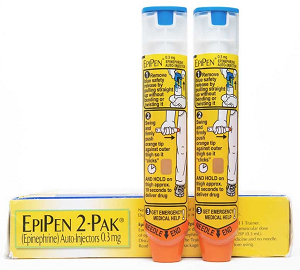
Epinephrine autoinjector
The epinephrine autoinjector (EpiPen, Auvi-Q, and similar) are small devices used to treat anaphylactic reactions.
Anaphylaxis is a severe allergic reaction, usually caused by stinging insects or allergies to food, latex, or medications. Often resulting in hives, itching, low blood pressure, and chest pain, the most severe reactions cause swelling of the tongue, lips, and airway, killing the victim by restricting their breathing. These reactions can take place in a matter of minutes — by the time EMS arrives, the patient could already be dead.
This can all be prevented by proper use of an epinephrine autoinjector. Be careful and only use it as directed as it can complicate other issues. Many people may already one, but for those that don’t, these are an easy to obtain and inexpensive way to save a life.

Automated external defibrillators (AED's)
Automated external defibrillators (AED's) have changed the game for patients with cardiac problems.
Small enough to keep in a desk drawer or in your vehicle, and often costing between $1,300 – $2,000, having an AED on-site is often the difference between life and death for somebody experiencing a heart attack.
Older versions of this guide noted that if you, or somebody in your immediate family or circle of friends has known cardiac problems or is likely to (older, obese, etc.), an AED is a purchase you should consider making. Since 2021, we are seeing a significant increase in otherwise healthy young men having cardiac events and an AED is now an "if you can afford it, you should have it" recommendation.
NOTE: Depending on where you live, you may require a physician’s prescription in order to purchase one, but most states do not require this.

Emergency Oxygen
Emergency oxygen can be the difference between life and death for some in special situations.
Oxygen administration is indicated in countless medical scenarios, from CPR to simply relieving discomfort to treating diving injuries like decompression sickness.
As with the epi-pen and AED, strongly consider adding an oxygen cylinder and regulator to your kit(s) if you or your family have conditions that might indicate its use.
For those that scuba dive, training should be covered in a rescue diver course and supplies are available through the Diver’s Alert Network (DAN). For everybody else, look to the Red Cross for training. Once you’re certified in oxygen use, you can get supplies from multiple vendors or local medical supply stores.
Some of the recommendations in this section may be over the top for many people, but once you've received some basic training, are not as far-fetched as you may think when you first run across them.
For anybody who truly lives a life of adventure, some type of medical training is a basic requirement. How much further you take it is up to you, but when possible, err on the side of being more prepared, rather than less.
The regular first-aid kit that most people have is a "nice-to-have." It'll take care of the day-to-day cuts, scrapes, and discomforts, and the glucose is inexpensive enough that it's a no-brainer addition to your medical kits.
The trauma kit, Epi-Pen, and AED, while more expensive and specialized, are the difference between life and death in the event of major trauma, allergic reaction, or heart attack. If you have the means, these are good additions to home and/or vehicle medical kits. For business owners, investing a couple thousand dollars in an AED and trauma kit (plus an Epi-Pen and glucose, but check your state laws for liability concerns), could save the lives of your customers, patrons, or employees. Spend the money, write it off, and be prepared to save a life.
From getting basic first aid training to take care of the minor cuts and bumps that come from a life well lived, to being able to manage the severe trauma one might find in an active shooter scenario or vehicle accident, living like a Gentleman Spy is all about being able to save the day.
Get the training. Get the gear. Save the day.
PROGRAM
DOWNLOADS
 First Aid Kit Checklist
First Aid Kit ChecklistDon't waste money with cheap drug-store first aid kits that never have what you need when you need it. Take the time to purchase a quality kit, or better yet, build your own. Download this checklist to cover all the bases, including those you probably never thought of before.
In the next lesson...
You spend hundreds or thousands of hours behind the wheel. Every year. Year after year. Driving is the most dangerous thing that most people ever do, and you do it for an hour or more every day. Upgrade your skills to make it more efficient, more comfortable, safer, and more fun.
